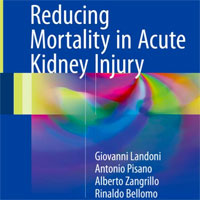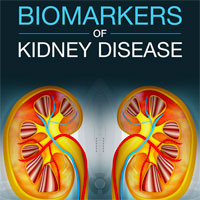Tag: AKI
Acute Kidney Injury Related to Intoxication From Synthetic Cannabis
Acute kidney injury (AKI) occurs infrequently in young patients and often raises concern for irreversible or deadly etiologies. However, AKI related to synthetic marijuana, colloquially known as K2, is an increasingly common... read more
Reducing Mortality in Acute Kidney Injury
This book describes the techniques, strategies, and drugs that have been demonstrated by at least one paper published in a peer-reviewed journal to significantly influence survival in patients with or at risk for acute kidney... read more

Multi-Organ Point-Of-Care Ultrasound in AKI
Acute kidney injury (AKI) is a clinical syndrome caused by a multitude of hemodynamic, toxic, and structural insults to the kidney, and portends worse patient outcomes. Despite careful history taking, physical examination,... read more
Balanced Crystalloids Probably Reduce Mortality in the Critically-Ill
As remarked by the authors of the recent PLUS trial, a systematic review and meta-analysis of randomized controlled trials comparing balanced resuscitation fluid to 0.9% saline was reported in the New England Journal of Medicine... read more
Balanced vs. Unbalanced Fluid in Critically Ill Children
Our systematic review found some evidence of improvement in blood pH and bicarbonate values in critically ill children after 4–12 hours of fluid bolus therapy with balanced fluid compared with the unbalanced fluid. However,... read more
Balanced Fluid Resuscitation for the Critically-Ill: the PLUS study mirrors the BaSICS
Intravenous fluid therapy is one of the most commonly-performed interventions in all of critical care medicine. Numerous trials over the last 20 years have attempted to identify the ideal fluid for those in the intensive... read more
Assessment of Patiromer Monotherapy for Hyperkalemia in an Acute Care Setting
In this cohort study of patients with acute, non–life-threatening hyperkalemia, a single dose of patiromer was associated with a significant decrease in serum potassium levels and a low incidence of hypokalemia. These... read more
The Ongoing Saga of Normal Saline vs. Balanced Fluids
I have discussed the ongoing battle between normal saline and ‘balanced fluids’ many times in the past. First, there was the SPLIT trial, a double blind cluster RCT of 2200 ICU patients that showed no difference between... read more
Prolonged Blood Storage and Risk of Posttransfusion AKI
In a population of patients without severely impaired baseline renal function receiving fewer than 10 erythrocyte units, duration of blood storage had no effect on the incidence of posttransfusion acute kidney injury (AKI). The... read more
Chlorthalidone Improves Blood Pressure Control in Advanced Chronic Kidney Disease with Hypertension
Among patients with advanced chronic kidney disease and poorly controlled hypertension, chlorthalidone therapy improved blood-pressure control at 12 weeks as compared with placebo. A total of 160 patients underwent randomization,... read more
Intraoperative Hypotension and AKI after Noncardiac Surgery in Infants and Children
In distinct contrast to adults, the authors did not find any association between intraoperative hypotension and postoperative renal injury. Avoiding short periods of hypotension should not be the clinician’s primary concern... read more
Obesity, Inflammatory and Thrombotic Markers, and Major Clinical Outcomes in Critically Ill Patients with COVID-19 in the US
In critically ill patients with COVID-19, higher BMI was not associated with death or thrombotic events but was associated with a greater risk of ARDS and AKI-RRT. The lack of an association between BMI and circulating... read more
Longitudinal Respiratory Subphenotypes in COVID-19 Patients with ARDS
COVID-19-related ARDS has no consistent respiratory subphenotype. Patients diverged from a fairly homogenous to a more heterogeneous population, with trajectories of ventilatory ratio and mechanical power being the most discriminatory.... read more
Optimizing the Timing of RRT in AKI
The optimal timing of renal replacement therapy (RRT) in critically ill patients with acute kidney injury (AKI) has been much debated. Over the past five years several studies have provided new guidance for evidence-based... read more
RRT in Critically Ill Patients with AKI
Recent evidence has shown that pre-emptive or earlier renal-replacement therapy (RRT) in patients with severe acute kidney injury (AKI) and no urgent indications does not confer clinical benefit. By default, this would imply... read more
Effects of 5% Albumin Plus Saline vs. Saline Alone on Outcomes From Large-Volume Resuscitation in Critically Ill Patients
During large-volume resuscitation, 5% albumin was associated with reduced mortality and major adverse kidney event at 30, 90, and 365 days. However, a higher rate of acute kidney injury of any stage was observed that did... read more
Delayed Strategies for RRT Initiation for Severe AKI
In severe acute kidney injury (AKI) patients with oliguria for more than 72 h or blood urea nitrogen concentration higher than 112 mg/dL and no severe complication that would mandate immediate RRT, longer postponing of renal... read more
Prior Exposure to Angiotensin II Receptor Blockers in Patients With Septic Shock to Individualize Mean Arterial Pressure Target?
Our results suggest that patients with septic shock and chronic hypertension treated with angiotensin II receptor blocker may benefit from a high mean arterial pressure target to reduce the risk of acute kidney injury occurrence. We... read more
Use of Biomarkers to Identify AKI to Help Detect Sepsis in Patients with Infection
Use of the urinary (tissue inhibitor of metalloproteinases-2) × (insulin-like growth factor binding protein 7) test could identify acute kidney injury in patients with infection, possibly helping to detect sepsis, nearly... read more
Contrast-enhanced Imaging in the Emergency Department
We continue with the topic of Contrast-enhanced imaging in the emergency department. "What is the creatinine?" asks the radiologist when an emergency contrast-enhanced computed tomography (CT) is requested for a patient with... read more
Comparison of Two Delayed Strategies for RRT initiation for severe AKI
Delaying renal replacement therapy (RRT) for some time in critically ill patients with severe acute kidney injury (AKI) and no severe complication is safe and allows optimisation of the use of medical devices. Major uncertainty... read more
Biomarkers of Kidney Disease
Biomarkers of Kidney Disease, Second Edition, focuses on the basic and clinical research of biomarkers in common kidney diseases, detailing the characteristics of an ideal biomarker. The latest techniques for biomarker detection,... read more










